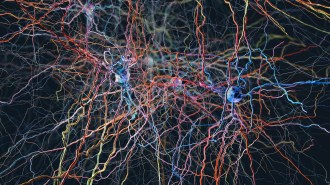Brain training can alter opinions of faces
Neurofeedback technique nudges people to shift neutral judgments to like or dislike

NEUROFEEDBACK Brain training method changed people’s judgments of faces and may hold promise for reducing harmful fears.
bowie15/iStockphoto
- More than 2 years ago
By sneakily influencing brain activity, scientists changed people’s opinions of faces. This covert neural sculpting relied on a sophisticated brain training technique in which people learn to direct their thoughts in specific ways.
The results, published September 8 in PLOS Biology, support the idea that neurofeedback methods could help reveal how the brain’s behavior gives rise to perceptions and emotions. What’s more, the technique may ultimately prove useful for easing traumatic memories and treating disorders such as depression. The research is still at an early stage, says neurofeedback researcher Michelle Hampson of Yale University, but, she notes, “I think it has great promise.”
Takeo Watanabe of Brown University and colleagues used functional MRI to measure people’s brain activity in an area called the cingulate cortex as participants saw pictures of faces. After participants had rated each face, a computer algorithm sorted their brain responses into patterns that corresponded to faces they liked and faces they disliked. With this knowledge in hand, the researchers then attempted to change people’s face preferences by subtly nudging brain activity in the cingulate cortex.
In step 2 of the experiment, returning to the fMRI scanner, participants saw an image of a face that they had previously rated as neutral. Just after that, they were shown a disk. The goal, the participants were told, was simple: make the disk bigger by using their brains. They had no idea that the only way to make the disk grow was to think in a very particular way.
For 12 people, the researchers made the disk grow when the participants’ brain activity looked like the activity that corresponded to faces they had liked in the first round. For 12 other people, the disk grew when their brain activity mirrored activity elicited by previously unliked faces. Another six people saw the faces, but didn’t do any disk training. This training lasted an hour each day for three days.
At the end of the training, people induced to call up brain activity similar to positive responses rated previously neutral faces as slightly more positive. “By doing this again and again, subjects began to like what was neutral before,” Watanabe says. And people who had called up activity associated with negative responses rated previously neutral faces as slightly more negative. People who hadn’t trained on the disk didn’t change their ratings. These opinion shifts lasted at least three months, later experiments showed.
Participants were simply told to make the disk bigger; they had no idea what the disk actually represented. “These results are fascinating in showing how nonconscious brain activity can be utilized to modify brain function and behavior in a targeted way,” says neuroscientist Rafi Malach of the Weizmann Institute of Science in Israel.
By showing that neurofeedback can influence complex mental processes, this study and others raise the possibility that similar methods could change the brain in desirable ways. Perhaps this sort of neural training could get rid of problematic patterns of thinking, such as those that come with abnormal fear and depression, Watanabe says.






